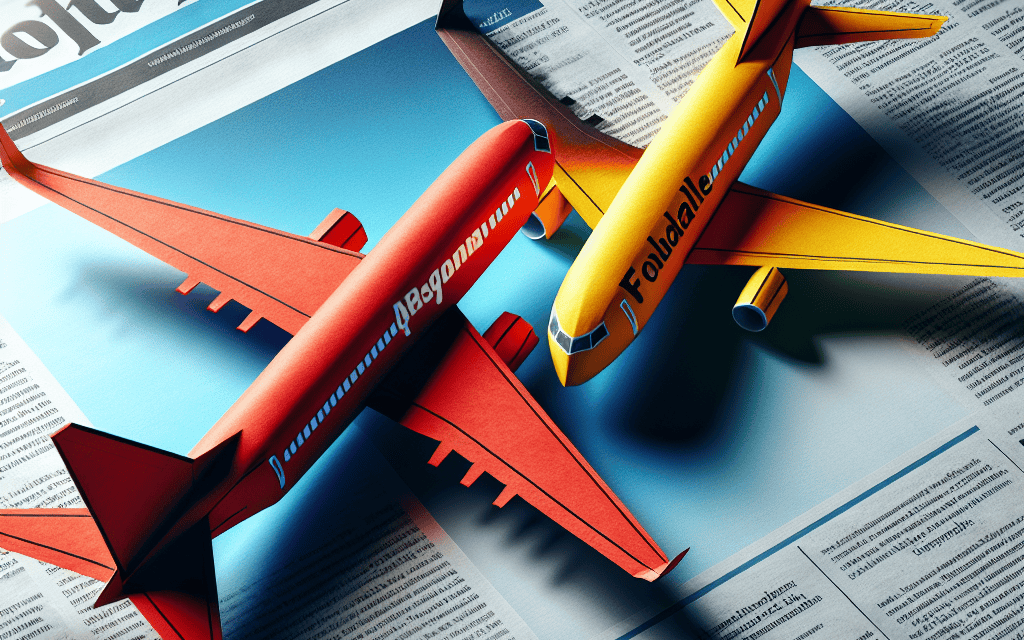“Frontier and Spirit: Reigniting the Journey to Affordable Air Travel”
Introduction
Frontier Airlines and Spirit Airlines have reportedly resumed discussions regarding a potential merger, according to a report by The Wall Street Journal. This development comes after previous negotiations between the two low-cost carriers were halted, sparking renewed interest in the possibility of creating a more formidable competitor in the budget airline sector. The merger, if successful, could lead to a significant reshaping of the market dynamics, offering expanded route networks and potentially more competitive pricing for consumers. Both airlines have been known for their no-frills service models, and a merger could enhance their operational efficiencies and market reach.
Impact Of Frontier And Spirit Airlines Merger On The Aviation Industry
The aviation industry is once again abuzz with the news that Frontier and Spirit Airlines have resumed merger discussions, as reported by the Wall Street Journal. This development marks a significant moment in the airline sector, as the potential merger between these two low-cost carriers could reshape the competitive landscape. The merger, if successful, would create a formidable entity in the budget airline market, potentially altering the dynamics of air travel in the United States.
To understand the potential impact of this merger, it is essential to consider the current state of the aviation industry. The sector has been gradually recovering from the severe disruptions caused by the COVID-19 pandemic. Airlines have been striving to regain financial stability while adapting to changing consumer preferences and fluctuating demand. In this context, a merger between Frontier and Spirit could provide both airlines with a strategic advantage, allowing them to pool resources, expand their network, and enhance operational efficiencies.
One of the primary benefits of the merger would be the creation of a larger, more competitive low-cost carrier. By combining their fleets and route networks, Frontier and Spirit could offer more destinations and increased flight frequencies, thereby attracting a broader customer base. This expanded reach could enable the merged entity to compete more effectively with other major airlines, particularly in the budget segment. Moreover, the merger could lead to cost synergies, as the airlines streamline operations and reduce redundancies, potentially resulting in lower fares for consumers.
However, the merger also raises concerns about market concentration and its implications for competition. Critics argue that the consolidation of two major low-cost carriers could reduce competition in certain markets, leading to higher prices and fewer choices for consumers. Regulatory authorities are likely to scrutinize the merger closely to ensure that it does not violate antitrust laws or harm consumer interests. The outcome of this regulatory review will be crucial in determining whether the merger proceeds and under what conditions.
In addition to regulatory challenges, the merger faces operational hurdles. Integrating two airlines with distinct corporate cultures, systems, and processes is a complex task that requires careful planning and execution. The success of the merger will depend on the ability of Frontier and Spirit to harmonize their operations while maintaining service quality and customer satisfaction. Furthermore, the airlines will need to address potential labor issues, as the integration process may affect employees’ roles and responsibilities.
Despite these challenges, the merger presents an opportunity for innovation and growth in the aviation industry. By leveraging their combined strengths, Frontier and Spirit could invest in new technologies, improve customer experience, and enhance sustainability initiatives. This could set a precedent for other airlines, encouraging them to explore similar partnerships or collaborations to remain competitive in a rapidly evolving market.
In conclusion, the resumption of merger discussions between Frontier and Spirit Airlines signifies a pivotal moment for the aviation industry. While the potential merger offers numerous benefits, including increased competitiveness and operational efficiencies, it also poses challenges related to market concentration and integration. As the discussions progress, stakeholders will be closely monitoring the developments to assess the merger’s impact on the industry and its implications for consumers. Ultimately, the success of this merger will depend on the airlines’ ability to navigate regulatory, operational, and strategic challenges while delivering value to their customers.
How The Frontier-Spirit Merger Could Affect Airfare Prices
The resumption of merger discussions between Frontier Airlines and Spirit Airlines, as reported by The Wall Street Journal, has reignited interest in the potential implications for airfare prices. This development comes after previous attempts to merge were thwarted, leaving industry analysts and consumers alike speculating on the possible outcomes. As two of the largest low-cost carriers in the United States, a merger between Frontier and Spirit could significantly alter the competitive landscape of the airline industry, with direct consequences for airfare pricing.
To begin with, the merger could lead to increased market concentration among low-cost carriers. By combining their resources, Frontier and Spirit would create a formidable entity capable of exerting greater influence over pricing strategies. This consolidation could potentially reduce competition, as the merged airline might dominate certain routes, leading to fewer choices for consumers. Consequently, with less competition, there is a risk that airfare prices could rise, particularly on routes where the new entity holds a significant market share. However, it is essential to consider that the merger could also result in operational efficiencies that might benefit consumers.
In addition to market concentration, the merger could lead to cost synergies that might impact airfare prices. By integrating their operations, Frontier and Spirit could achieve economies of scale, reducing operational costs. These savings could, in theory, be passed on to consumers in the form of lower ticket prices. For instance, the combined airline might be able to negotiate better deals with suppliers, streamline maintenance operations, and optimize flight schedules, all of which could contribute to cost reductions. However, whether these savings would be transferred to consumers or retained to boost profitability remains uncertain.
Moreover, the merger could stimulate innovation in the low-cost carrier segment, potentially affecting airfare prices. As a larger entity, the combined airline might have more resources to invest in technology and customer service improvements. This could lead to enhanced passenger experiences, such as more efficient booking systems or improved in-flight services, which might justify higher ticket prices. On the other hand, increased innovation could also lead to more competitive pricing strategies, as the airline seeks to attract a broader customer base by offering better value for money.
Furthermore, the merger could prompt responses from other airlines, influencing airfare prices across the industry. Competing carriers might adjust their pricing strategies to maintain market share, potentially leading to price wars that could benefit consumers. Alternatively, if the merger results in a dominant player in the low-cost segment, other airlines might focus on differentiating their services rather than competing on price alone, which could lead to a stabilization or even an increase in airfare prices.
In conclusion, the resumption of merger discussions between Frontier and Spirit Airlines presents a complex scenario with multiple potential outcomes for airfare prices. While the merger could lead to increased market concentration and reduced competition, it also offers opportunities for cost synergies and innovation that might benefit consumers. The ultimate impact on airfare prices will depend on how the merged airline chooses to leverage its newfound scale and resources, as well as the responses from competitors in the industry. As such, stakeholders will be closely monitoring the situation to assess the long-term implications for the airline market and consumer pricing.
Potential Benefits For Consumers From The Frontier And Spirit Airlines Merger
The resumption of merger discussions between Frontier and Spirit Airlines, as reported by the Wall Street Journal, has reignited interest in the potential benefits such a consolidation could offer to consumers. As the airline industry continues to recover from the disruptions caused by the global pandemic, the merger of these two low-cost carriers could significantly reshape the competitive landscape, offering a range of advantages to travelers.
Firstly, one of the most immediate benefits for consumers could be the expansion of route networks. By combining their resources, Frontier and Spirit Airlines would likely be able to offer a more extensive array of destinations. This expansion could provide travelers with more options for direct flights, reducing the need for layovers and making travel more convenient. Moreover, the merger could lead to increased frequency of flights on popular routes, giving consumers greater flexibility in planning their travel itineraries.
In addition to expanded route networks, the merger could also result in more competitive pricing. Historically, both Frontier and Spirit have been known for their low-cost business models, which focus on providing affordable base fares while charging for additional services. By merging, the airlines could achieve economies of scale, potentially reducing operational costs. These savings could be passed on to consumers in the form of lower ticket prices, making air travel more accessible to a broader audience. Furthermore, the increased competition with other major carriers could pressure the industry to maintain competitive pricing, benefiting consumers across the board.
Another potential advantage of the merger is the enhancement of customer service and experience. While both airlines have faced criticism in the past for their no-frills approach, the consolidation could provide an opportunity to invest in improving service quality. By pooling their resources, Frontier and Spirit could enhance their customer service training programs, streamline operations, and invest in technology to improve the overall passenger experience. This could lead to more efficient check-in processes, better in-flight services, and improved handling of customer inquiries and complaints.
Moreover, the merger could foster innovation within the low-cost carrier segment. As a larger entity, the combined airline would have greater financial and operational capacity to invest in new technologies and sustainable practices. This could include the adoption of more fuel-efficient aircraft, the implementation of advanced booking and check-in systems, and the exploration of alternative energy sources. Such innovations could not only reduce the environmental impact of air travel but also enhance the overall efficiency and reliability of services offered to consumers.
While the potential benefits of the merger are significant, it is important to acknowledge that such a consolidation would also require careful regulatory scrutiny to ensure that it does not lead to reduced competition or monopolistic practices. Regulators would need to assess the impact on market dynamics and ensure that the merger aligns with consumer interests. However, if executed thoughtfully, the merger of Frontier and Spirit Airlines could serve as a catalyst for positive change within the airline industry, ultimately benefiting consumers through expanded choices, competitive pricing, and improved service quality.
In conclusion, the resumption of merger discussions between Frontier and Spirit Airlines presents a promising opportunity for consumers. By expanding route networks, enhancing competitive pricing, improving customer service, and fostering innovation, the merger has the potential to deliver substantial benefits to travelers. As the discussions progress, stakeholders will be keenly observing how this potential merger could redefine the landscape of low-cost air travel, offering a more dynamic and consumer-friendly experience.
Challenges Facing The Frontier And Spirit Airlines Merger

The resumption of merger discussions between Frontier Airlines and Spirit Airlines, as reported by the Wall Street Journal, marks a significant development in the aviation industry. This potential merger, however, is not without its challenges. As both airlines navigate the complexities of combining operations, they must address a myriad of issues that could impact the success of their union. One of the primary challenges facing the merger is regulatory scrutiny. The airline industry is heavily regulated, and any consolidation of major players is likely to attract the attention of antitrust authorities. Regulators will be keen to ensure that the merger does not lead to reduced competition, higher fares, or diminished service quality for consumers. Therefore, Frontier and Spirit must present a compelling case that their merger will benefit the market and passengers alike, perhaps by highlighting potential efficiencies and service improvements.
In addition to regulatory hurdles, the integration of corporate cultures poses another significant challenge. Frontier and Spirit, while both operating in the low-cost carrier segment, have distinct corporate identities and operational philosophies. Successfully merging these cultures will require careful planning and execution to ensure that employees from both airlines feel valued and motivated. This cultural integration is crucial, as employee morale can directly impact customer service and operational efficiency. Furthermore, the airlines must address potential operational challenges that could arise from the merger. Integrating fleets, aligning schedules, and consolidating routes are complex tasks that require meticulous coordination. Any missteps in these areas could lead to operational disruptions, negatively affecting customer satisfaction and the airlines’ reputations. Therefore, a detailed integration plan that minimizes disruptions and maximizes synergies is essential for a smooth transition.
Financial considerations also play a critical role in the merger process. Both airlines must evaluate the financial implications of the merger, including potential cost savings and revenue synergies. However, they must also be mindful of the costs associated with the integration process itself, such as technology upgrades, rebranding efforts, and potential redundancies. Ensuring that the merger is financially viable in the long term is crucial for the success of the combined entity. Moreover, customer perception and loyalty are vital factors that the airlines must consider. Both Frontier and Spirit have established customer bases that may have differing expectations and preferences. The airlines must carefully manage communication with their customers to ensure that they understand the benefits of the merger and how it will affect their travel experiences. Maintaining customer loyalty during the transition period is essential to prevent a loss of market share to competitors.
Lastly, the broader economic environment can influence the merger’s success. The airline industry is susceptible to fluctuations in fuel prices, economic downturns, and changes in consumer travel behavior. Both airlines must be prepared to adapt their strategies to navigate these external challenges while pursuing the merger. In conclusion, while the resumption of merger discussions between Frontier and Spirit Airlines presents an opportunity for growth and increased competitiveness, it also brings a host of challenges that must be carefully managed. By addressing regulatory concerns, integrating corporate cultures, overcoming operational hurdles, ensuring financial viability, maintaining customer loyalty, and adapting to the economic environment, the airlines can position themselves for a successful merger that benefits both their operations and their customers.
Regulatory Hurdles In The Frontier And Spirit Airlines Merger Process
The resumption of merger discussions between Frontier Airlines and Spirit Airlines, as reported by the Wall Street Journal, marks a significant development in the aviation industry. This potential merger, which has been on the table for some time, is poised to reshape the competitive landscape of low-cost carriers in the United States. However, as with any major corporate consolidation, the path forward is fraught with regulatory hurdles that both airlines must navigate carefully.
To begin with, the merger between Frontier and Spirit Airlines is likely to attract scrutiny from antitrust regulators. The primary concern for regulators is whether the merger would reduce competition in the airline industry, potentially leading to higher fares and fewer choices for consumers. Given that both Frontier and Spirit are known for their ultra-low-cost business models, their consolidation could significantly alter the dynamics of budget air travel. Consequently, the Department of Justice (DOJ) and the Federal Trade Commission (FTC) are expected to closely examine the merger’s implications on market competition.
Moreover, the merger discussions come at a time when the airline industry is still recovering from the impacts of the COVID-19 pandemic. The pandemic has already led to a wave of consolidations and strategic alliances as airlines seek to stabilize their operations and improve profitability. In this context, regulators may be particularly vigilant in ensuring that any merger does not disadvantage consumers or lead to monopolistic practices. Therefore, Frontier and Spirit will need to present a compelling case that their merger will benefit the public by enhancing service offerings and maintaining competitive pricing.
In addition to antitrust concerns, the merger will also need to address regulatory issues related to operational integration. Merging two airlines involves complex logistical challenges, including the harmonization of fleets, alignment of operational procedures, and integration of workforce cultures. These factors can pose significant regulatory challenges, as authorities will need to ensure that the merged entity can maintain safety standards and service quality. Furthermore, the airlines will need to work closely with the Federal Aviation Administration (FAA) to ensure compliance with all aviation regulations during the integration process.
Another critical aspect of the regulatory landscape is the potential impact on labor relations. Both Frontier and Spirit have sizable workforces, and any merger will necessitate negotiations with labor unions to address concerns related to job security, wages, and working conditions. Regulators will be keen to ensure that the merger does not lead to unfair labor practices or significant job losses. Therefore, effective communication and negotiation with labor representatives will be essential to smooth the regulatory approval process.
In conclusion, while the resumption of merger discussions between Frontier and Spirit Airlines presents an opportunity to create a formidable player in the low-cost airline sector, the path to completion is laden with regulatory challenges. Antitrust scrutiny, operational integration, and labor relations are just a few of the hurdles that must be addressed to secure approval from regulators. As the discussions progress, both airlines will need to demonstrate that their merger will not only enhance their competitive position but also deliver tangible benefits to consumers and the broader aviation industry. The outcome of these discussions will undoubtedly have far-reaching implications for the future of air travel in the United States.
Historical Context: Previous Airline Mergers And Their Outcomes
The resumption of merger discussions between Frontier and Spirit Airlines, as reported by the Wall Street Journal, brings to mind the historical context of airline mergers and their outcomes. Over the past few decades, the airline industry has witnessed a series of consolidations, each reshaping the competitive landscape and impacting consumers in various ways. To understand the potential implications of a Frontier-Spirit merger, it is essential to examine previous airline mergers and their outcomes.
Historically, airline mergers have been driven by the pursuit of operational efficiencies, expanded networks, and increased market share. One of the most notable mergers in recent history was the 2008 combination of Delta Air Lines and Northwest Airlines. This merger created one of the world’s largest airlines, allowing Delta to expand its international reach and streamline operations. The integration process, while complex, ultimately resulted in a more robust airline capable of competing on a global scale. However, it also led to concerns about reduced competition and higher fares on certain routes.
Similarly, the 2010 merger between United Airlines and Continental Airlines further exemplifies the trend of consolidation in the industry. This merger aimed to create a more comprehensive network and improve service offerings. While the integration faced initial challenges, such as aligning different corporate cultures and systems, the long-term outcome was a stronger airline with a more extensive route network. Nevertheless, this consolidation also sparked debates about the potential for decreased competition and its impact on consumers.
In 2013, American Airlines and US Airways merged to form the world’s largest airline at the time. This merger was primarily motivated by the need to emerge from bankruptcy and compete more effectively with other major carriers. The integration process was arduous, involving the harmonization of fleets, systems, and labor contracts. Despite these challenges, the merger allowed American Airlines to achieve significant cost savings and expand its global presence. However, as with previous mergers, concerns about reduced competition and fare increases were raised.
The potential merger between Frontier and Spirit Airlines must be viewed within this historical context. Both airlines operate as ultra-low-cost carriers, focusing on providing affordable travel options to price-sensitive consumers. A merger between the two could create a more formidable competitor in the low-cost segment, potentially leading to increased efficiencies and a broader network. However, it also raises questions about the impact on competition, particularly in markets where both airlines currently operate.
Moreover, the integration of two ultra-low-cost carriers presents unique challenges. Aligning business models, operational practices, and customer service philosophies will be crucial to the success of the merger. Additionally, regulatory scrutiny is likely, as authorities assess the potential impact on competition and consumer choice.
In conclusion, the resumption of merger discussions between Frontier and Spirit Airlines highlights the ongoing trend of consolidation in the airline industry. By examining previous airline mergers and their outcomes, it becomes evident that while mergers can lead to operational efficiencies and expanded networks, they also raise concerns about competition and consumer impact. As Frontier and Spirit navigate this complex process, the lessons learned from past mergers will undoubtedly play a crucial role in shaping their approach and determining the ultimate success of their union.
Future Prospects For Low-Cost Carriers Post Frontier-Spirit Merger
The resumption of merger discussions between Frontier Airlines and Spirit Airlines, as reported by the Wall Street Journal, marks a significant development in the landscape of low-cost carriers. This potential merger, if realized, could reshape the competitive dynamics of the airline industry, particularly in the budget travel segment. As both airlines are known for their no-frills, cost-effective services, their union could create a formidable entity capable of challenging larger carriers while offering enhanced value to budget-conscious travelers.
In recent years, the demand for low-cost travel options has surged, driven by a combination of economic factors and changing consumer preferences. Travelers increasingly prioritize affordability and flexibility, often opting for basic services over luxury amenities. This trend has provided fertile ground for low-cost carriers to expand their market share. The proposed merger between Frontier and Spirit could further capitalize on this trend by leveraging their combined resources to offer even more competitive pricing and expanded route networks.
Moreover, the merger could lead to operational efficiencies that benefit both the airlines and their customers. By consolidating their operations, Frontier and Spirit could achieve economies of scale, reducing costs associated with maintenance, staffing, and fuel. These savings could be passed on to consumers in the form of lower fares, thereby enhancing the appeal of low-cost carriers in a market that remains highly price-sensitive. Additionally, a merged entity could streamline its fleet, optimizing aircraft utilization and improving overall service reliability.
However, the merger also presents potential challenges and regulatory hurdles. The consolidation of two major players in the low-cost segment could raise antitrust concerns, as regulators may scrutinize the deal to ensure it does not stifle competition or harm consumer interests. It will be crucial for Frontier and Spirit to demonstrate that their merger will not lead to reduced service quality or increased fares. Instead, they must emphasize the potential benefits, such as improved connectivity and expanded service offerings, which could enhance consumer choice.
Furthermore, the integration of two distinct corporate cultures and operational models poses its own set of challenges. Successfully merging the workforce, aligning business strategies, and maintaining service standards will require careful planning and execution. Both airlines will need to navigate these complexities to ensure a seamless transition that preserves the strengths of each brand while creating a unified identity.
Looking ahead, the potential merger of Frontier and Spirit could set a precedent for further consolidation in the low-cost carrier sector. As the airline industry continues to recover from the impacts of the COVID-19 pandemic, carriers are seeking ways to bolster their resilience and competitiveness. Mergers and strategic partnerships may become increasingly attractive options for airlines aiming to expand their market presence and enhance operational efficiency.
In conclusion, the resumption of merger discussions between Frontier and Spirit Airlines represents a pivotal moment for the future of low-cost carriers. By potentially combining their strengths, these airlines could offer enhanced value to travelers while navigating the challenges of a competitive and evolving industry. As the merger progresses, stakeholders will closely monitor its implications for market dynamics, regulatory compliance, and consumer benefits. Ultimately, the success of this merger could redefine the landscape of budget air travel, setting the stage for a new era of affordable and accessible flying options.
Q&A
1. **What airlines are involved in the merger discussions?**
Frontier Airlines and Spirit Airlines.
2. **What is the source of the report on the merger discussions?**
The Wall Street Journal (WSJ).
3. **What is the nature of the discussions between Frontier and Spirit Airlines?**
They are resuming merger discussions.
4. **Why are Frontier and Spirit Airlines considering a merger?**
To potentially create a larger low-cost carrier in the U.S. market.
5. **What was the outcome of previous merger talks between Frontier and Spirit?**
Previous talks did not result in a merger, as Spirit eventually merged with JetBlue.
6. **What could be a potential benefit of the merger for consumers?**
Increased competition in the low-cost airline market, potentially leading to lower fares.
7. **What regulatory challenges might the merger face?**
Antitrust scrutiny from U.S. regulators concerned about reduced competition.
Conclusion
Frontier and Spirit Airlines have resumed merger discussions, as reported by the Wall Street Journal. This development suggests a renewed interest in consolidating operations to potentially create a more competitive low-cost carrier in the U.S. market. The merger could lead to increased market share, operational efficiencies, and expanded route networks for the combined entity. However, it may also face regulatory scrutiny and concerns about reduced competition. The outcome of these discussions will significantly impact the landscape of budget air travel in the United States.





